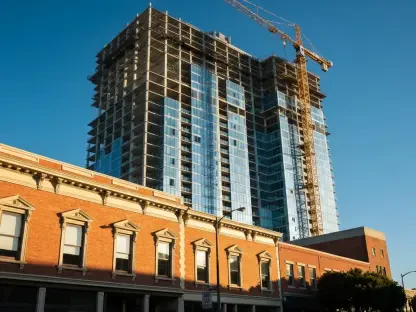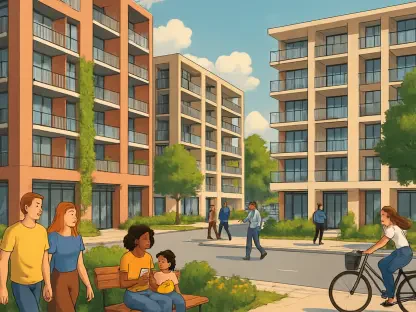The housing crisis in Australia continues to escalate, with affordability plummeting to levels that challenge even the most optimistic economic forecasts. Against this backdrop, modular homes have emerged as a potential lifeline, offering quick and affordable solutions that traditional construction methods fail to deliver. These homes, akin to flatpack furniture, are constructed in modules within a factory and later assembled on-site, bypassing many conventional building challenges. The modular model promises reduced build times and cost-effectiveness, capturing the attention of policymakers and industry leaders alike. This innovative approach is particularly gaining traction in Western Australia, where regional areas have felt the crunch of limited trade access and soaring construction costs. As the winds of change sweep through the housing sector, the pertinent question remains: Can modular homes viably address Australia’s affordability crisis?
Modular Homes: Western Australia’s Strategic Solution
In response to an enduring housing shortage, the Western Australian Government has positioned modular homes as a strategic cornerstone in its battle against housing deficiencies, particularly in regional areas. Their recent budget illustrates this commitment by launching a low deposit modular loan product facilitated through Keystart. This initiative aims to make homeownership more accessible by lowering entry costs, specifically targeting regional Western Australia. By tailoring solutions to areas traditionally hindered by geographical and economic constraints, the government hopes to make modular homes not just a stopgap measure but a long-term strategy for affordable housing.
Expanding the lens beyond Western Australia, the modular movement echoes across different parts of the country. The Queensland Government’s QBuild Modern Methods of Construction program reflects a similar dedication to integrating modular solutions into the social and affordable housing mix. The federal government’s endorsement, highlighted through a significant $54 million allocation towards modular construction, further underscores the paradigm shift. A portion of this financial backing is directed towards expediting planning approvals through a voluntary national certification process, which aims to tackle one of the primary barriers to widespread modular home acceptance. This multifaceted strategy not only emphasizes speed and affordability but also seeks to streamline processes that have historically been bottlenecks in the prefabricated home sector.
Affordability and Efficiency: The Promise of Modular Homes
Industry voices, including influential figures like REIWA President Suzanne Brown, have highlighted the dual benefit of modular homes: boosting affordability while simultaneously rejuvenating housing supply. This aspect is particularly poignant in regions grappling with exorbitant building costs and a dwindling workforce. Industry reports project a future where modular homes could comprise as much as ten percent of new builds nationwide by 2027, signifying a substantial shift in housing trends. This growing acceptance is fueled by evidence that modular homes can lead to productivity increases in a sector that has witnessed a steady decline.
While these homes offer a reduction in construction time, challenges such as elongated planning approvals and complex financing structures have slowed broader adoption. However, recent projections estimate potential cost savings of up to 20 percent, provided that regulatory bottlenecks, labor shortages, and funding hurdles are effectively addressed. Modular construction thus finds itself at a crossroads, where overcoming historical skepticism and structural challenges may unveil a future of increased feasibility and acceptance in the broader housing market.
Navigating Regulatory and Industry Challenges
The modular housing conversation includes addressing entrenched structural challenges within the industry. The National Construction Code’s prevailing inclination towards traditional on-site methods has often hamstrung modular construction initiatives, generating uncertainty in approval processes. This ongoing issue exacerbates productivity concerns as noted by the Productivity Commission, which has highlighted decreasing building completions relative to labor invested over recent decades. Layered against the country’s burgeoning population demands, these constraints amplify the housing affliction, urging a pivot towards more dynamic construction methodologies.
In response, collaborative efforts spearheaded by the Australian Building Codes Board and industry experts are paving pathways toward clearer regulatory frameworks. The release of a prefabricated construction handbook seeks to align modular homes with stringent safety, sustainability, and code compliance criteria, aiming to resolve historical setbacks. By easing developer apprehension through well-articulated guidelines, this initiative endeavors to foster confidence in modular technology among financiers and consumers alike, positioning these homes as viable, future-proof alternatives within Australia’s housing narrative.
Technology and Sustainability: The Modular Advantage
In tackling the ongoing housing shortage, the Government of Western Australia has framed modular homes as a pivotal strategy, especially in alleviating housing issues in regional zones. The latest budget emphasizes this focus by introducing a low deposit modular loan product via Keystart, aiming to reduce entry barriers to homeownership with a focus on regional Western Australia. These efforts address regions typically challenged by geographic and economic constraints, positioning modular homes as more than just temporary fixes, but as a sustainable long-term approach for affordable housing solutions.
Looking beyond Western Australia, this modular housing trend extends across Australia. In Queensland, the government’s QBuild Modern Methods of Construction program mirrors a similar commitment to embedding modular homes into the affordable housing framework. On a national scale, the federal government supports modular construction with a notable $54 million investment, highlighting a broader paradigm shift. This investment includes streamlining planning approvals via a voluntary national certification process, designed to overcome significant obstacles to modular home adoption, emphasizing not only affordability and speed but also efficient operational processes.









